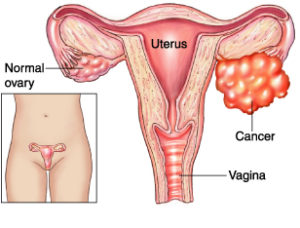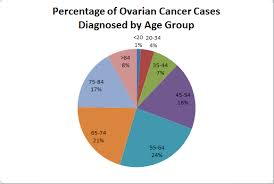Most people are aware that October is Breast Cancer Awareness Month, but how many of you are also aware that September is Ovarian Cancer Awareness Month? This cancer is the more silent sister to breast cancer which takes over the month of October with a worldwide pink party and numerous product promotions, some tasteful and some less so. Maybe people and product promoters are just drawn to pink versus the more reserved teal blue color for ovarian cancer. More likely it’s because breasts are visual and ovaries are invisible to the eye. But ovarian cancer is very visible to those diagnosed and to their loved ones.
We need to make more noise about ovarian cancer awareness. But first you have to listen… to your body. Ovarian cancer can be sneaky. Symptoms, such as indigestion, bloating, painful intercourse, menstrual irregularities and back pain, can point to other less invasive conditions. While breast cancer has screening protocols like mammograms and breast self-examination, there is no reliable screening for ovarian cancer. Unfortunately for many women the disease is often detected at an advanced stage. Both breast and ovarian cancer are diagnosed in women of all ages and ethnic backgrounds.
Ovarian cancer is a type of cancer that begins in the ovaries. Women have two ovaries, one on each side of the uterus. The ovaries — each about the size of an almond — produce eggs (ova) as well as the hormones estrogen and progesterone.
Ovarian cancer often goes undetected until it has spread within the pelvis and abdomen. At this late stage, ovarian cancer is more difficult to treat and is frequently fatal. Early-stage ovarian cancer, in which the disease is confined to the ovary, is more likely to be treated successfully.
Surgery and chemotherapy are generally used to treat ovarian cancer.
Early-stage ovarian cancer rarely causes any symptoms. Advanced-stage ovarian cancer may cause few and nonspecific symptoms that are often mistaken for more common benign conditions, such as constipation or irritable bowel.
Signs and symptoms of ovarian cancer may include and don’t ever ignore them:
- Abdominal bloating or swelling
- Quickly feeling full when eating
- Weight loss
- Discomfort in the pelvis area
- Changes in bowel habits, such as constipation or diarrhea
- A frequent need to urinate (urgency including difficulty to void)
- Increased Abdominal Size
- Painful Sex
- Heavy menstrual bleeding
- ***When to see a doctorIf you have a family history of ovarian cancer or breast cancer, talk to your doctor about your risk of ovarian cancer. Your doctor may refer you to a genetic counselor to discuss testing for certain gene mutations that increase your risk of breast and ovarian cancers. Only a small number of women are found to have genetic mutations that can lead to ovarian cancer.Certain factors may increase your risk of ovarian cancer. Look at Risk Factors:
- Age. Ovarian cancer can occur at any age but is most common in women ages 50 to 60 years.
- Inherited gene mutation. A small percentage of ovarian cancers are caused by an inherited gene mutation. The genes known to increase the risk of ovarian cancer are called breast cancer gene 1 (BRCA1) and breast cancer gene 2 (BRCA2). These genes were originally identified in families with multiple cases of breast cancer, which is how they got their names, but women with these mutations also have a significantly increased risk of ovarian cancer.
- The gene mutations that cause Lynch syndrome, which is associated with colon cancer, also increase a woman’s risk of ovarian cancer.
- Estrogen hormone replacement therapy, especially with long-term use and in large doses.
- Age when menstruation started and ended. If you began menstruating before age 12 or underwent menopause after age 52, or both, your risk of ovarian cancer may be higher.
- Never being pregnant.
- Fertility treatment.
- Smoking.
- Use of an intrauterine device.
- Polycystic ovary syndrome.
How is ovarian cancer diagnosed?
Ovarian cancer is difficult to diagnose. Screening tests, such as ultrasounds and computed tomography (CT) scans, show masses around the pelvis, which can suggest ovarian cancer. Removing part of the tumor for testing is the only way to officially diagnose ovarian cancer.
Finding ovarian cancer before it spreads is critical—when found early, about 94% of women live longer than 5 years after diagnosis. While there are currently no effective screening tests for ovarian cancer, there are scientific studies in progress to help determine ways to detect ovarian cancer.
What are the treatments?
1-Surgery is the first course of treatment for most women with ovarian cancer. Surgery to remove as much of the cancerous tissue as possible is called debulking. Its purpose is to remove all of the cancer that can be seen.
2-Chemotherapy is a drug that enters the bloodstream to kill cancer cells. This type of treatment works by killing cells in the body that divide frequently. The drawback of chemotherapy is that it also kills healthy cells, resulting in harsh side effects.
Chemotherapy can be injected into a vein, injected into the abdomen, or given by mouth. Ovarian cancer is usually treated with 2 or more types of drugs every 1 to 4 weeks.
The first group contains a platinum-based medicine and is thought to interfere with the DNA structure of the cancer cells, which stops them from making new cells, thus causing cancer cell death
Than a non platinum based medicine as another choice, collectively called taxanes. These disrupt cancer cell division.
3-Radiation therapy uses high-energy X-rays to kill cancer cells. This type of treatment can be useful in areas where the cancer has spread. This treatment is not used as a primary treatment.
4-Targeted therapy uses a type of drug that can target cancer cells.
DNA damage that is not repaired can lead to cell death, which can be a good thing in cancer cells. When someone with a BRCA mutation uses certain types of targeted therapy, DNA damage in cancer cells is less likely to be repaired, leading to cancer cell death.
5- Hormone therapy uses hormones or hormone-blocking drugs to attempt in killing cancer cells. It works by blocking hormones from working or lowering hormone levels to slow tumor growth.
6-There are also clinical trials provide the opportunity to study promising new treatments and procedures just like many other cancers.

